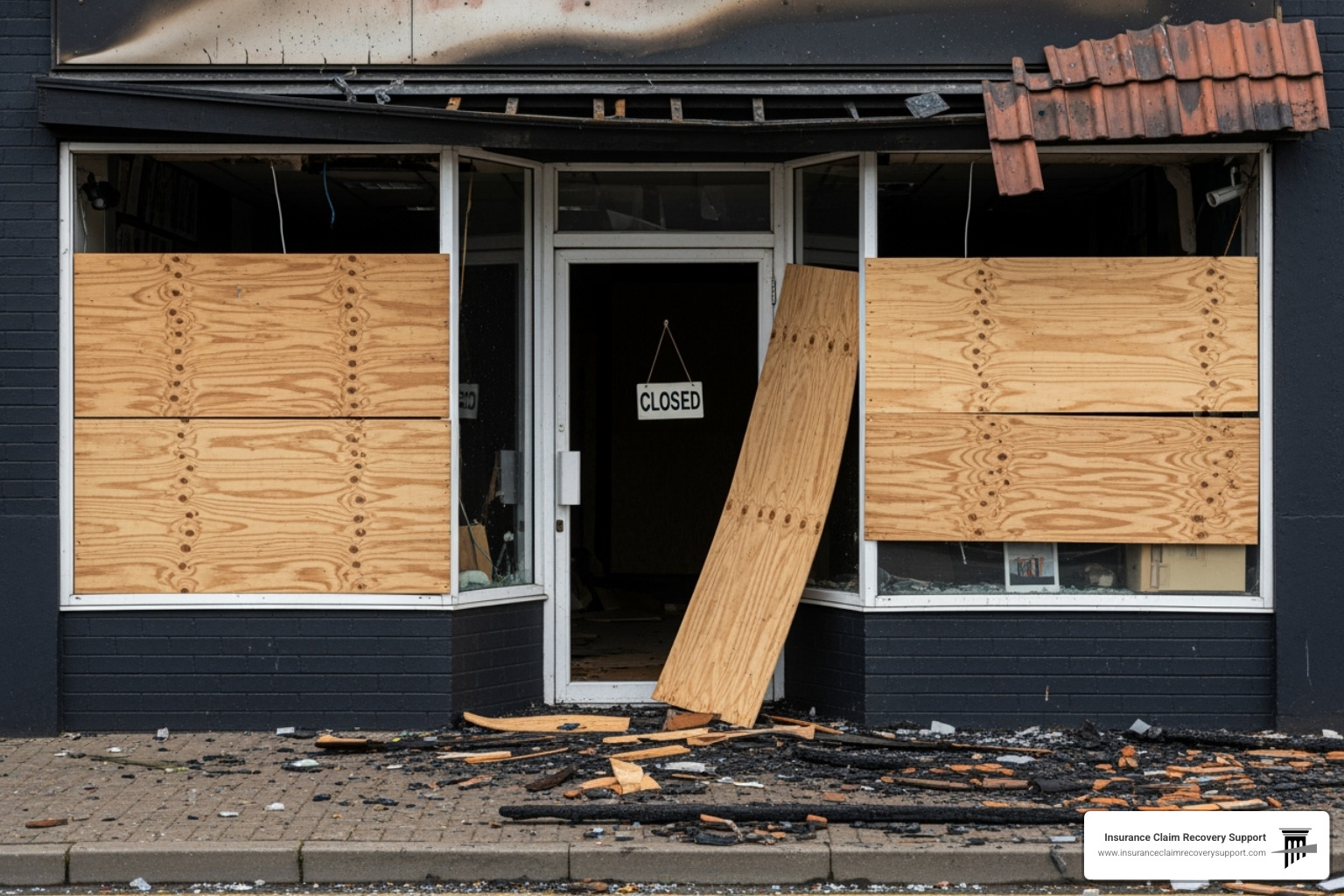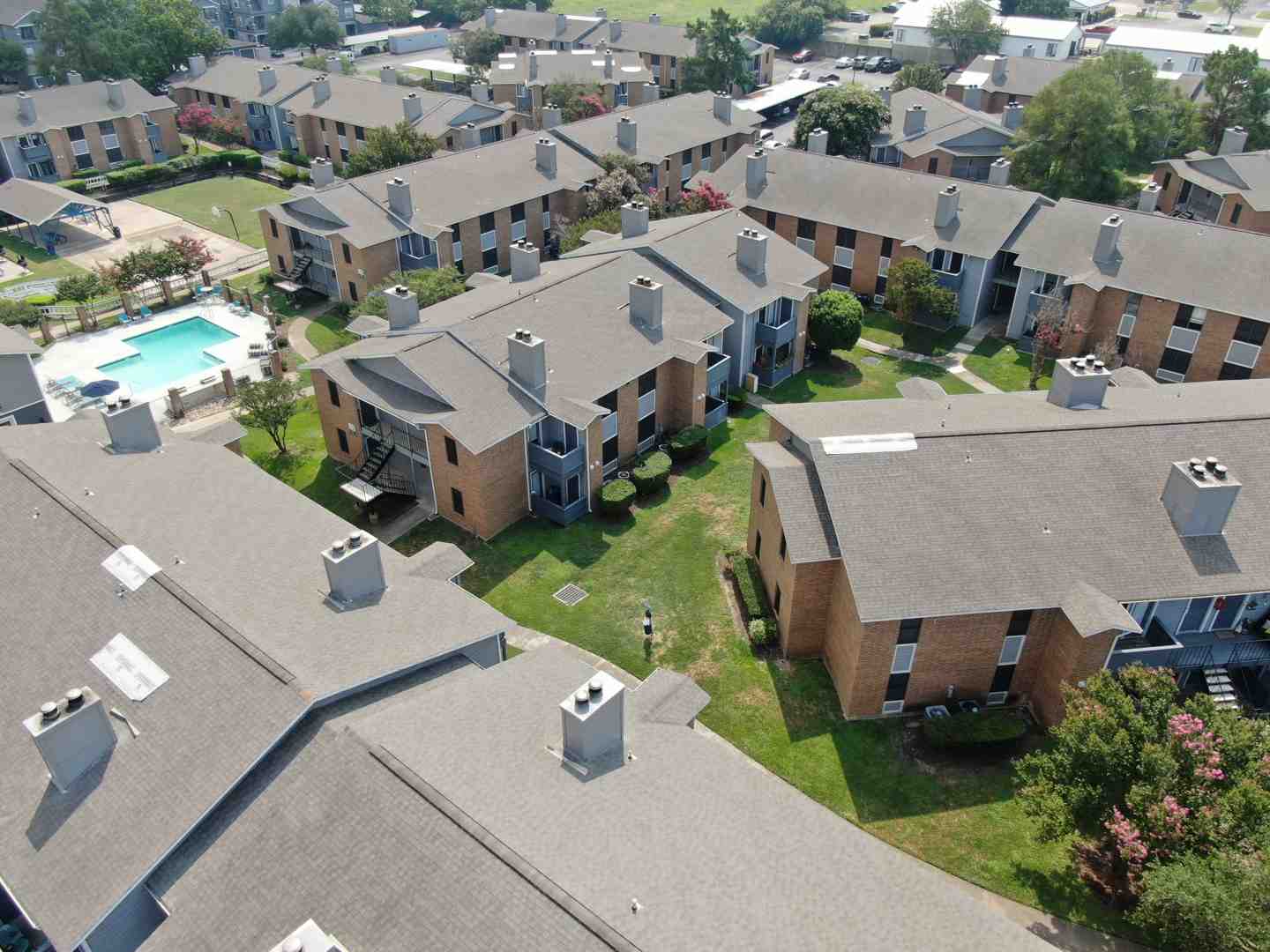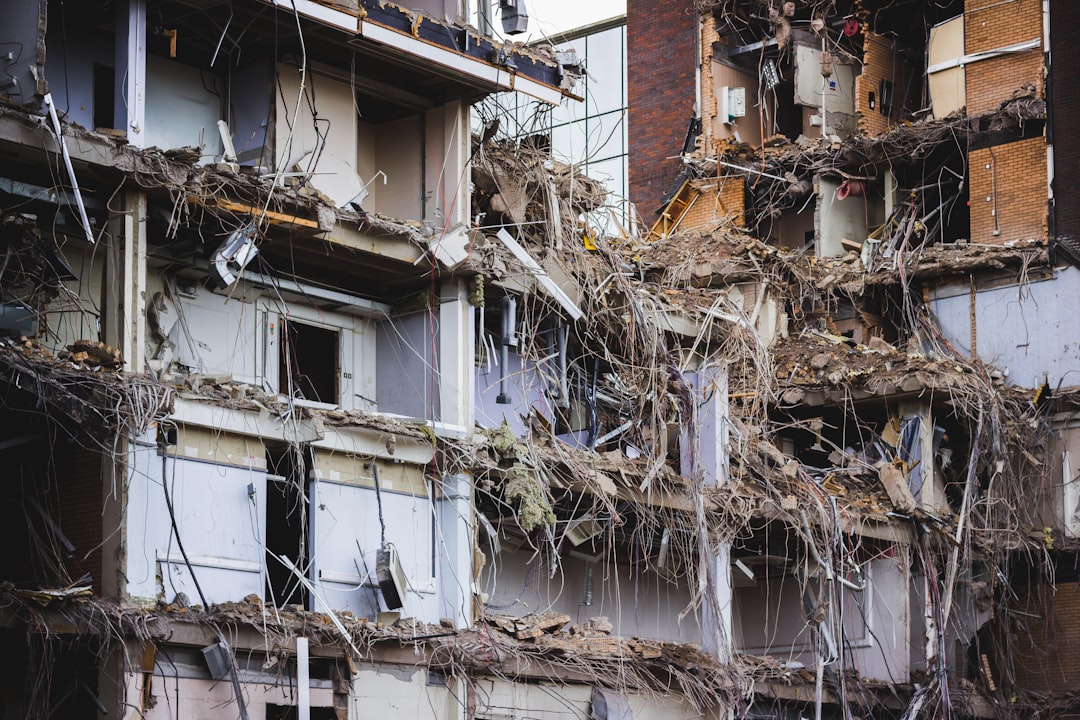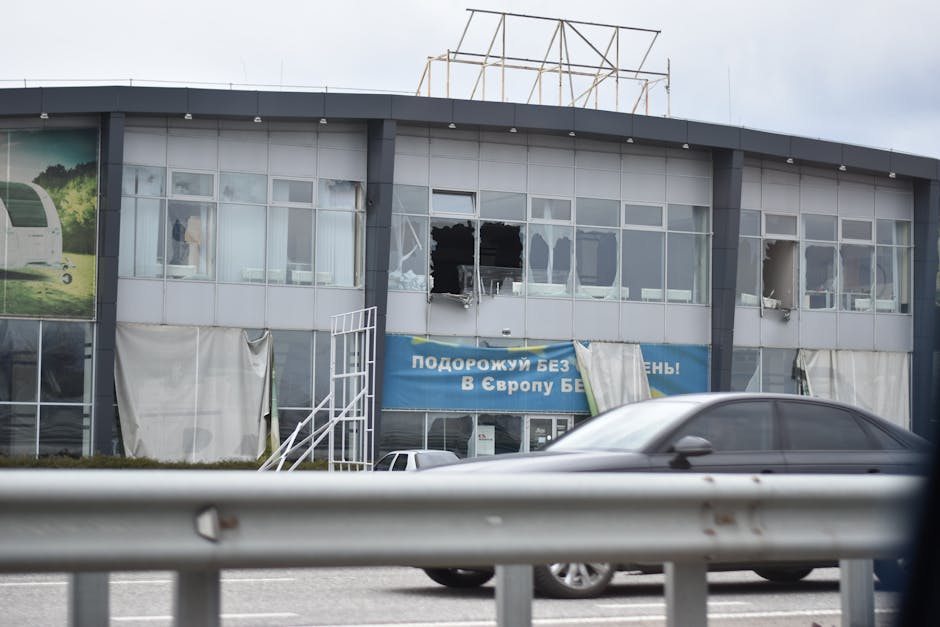Fire Damage Claim Help
Dealing with fire damage at a commercial property can be overwhelming, especially in Texas, where fires are common. Here’s a simplified checklist to help you get started with your fire damage claim:
- Report the Fire: Contact your insurance company immediately. Quick reporting is key to starting your claim process.
- Secure the Property: Prevent further damage by securing windows, doors, and the roof. This shows your insurer you’re taking steps to minimize additional losses.
- Document Everything: Take photos and videos of all affected areas, including structural damage, smoke, and soot. Keep a detailed inventory of damaged items.
- Track Expenses: Save receipts for any costs incurred due to the fire, such as temporary repairs, lodging, or lost business income.
- Call a Public Adjuster: Consider hiring a public adjuster to help steer the claims process and ensure you receive a fair settlement.
In the aftermath of a fire, knowing the next steps can make a significant difference. Fires don’t just leave behind ashes and debris; they also introduce a maze of insurance protocols that can be overwhelming. But don’t stress—you’re not alone. Managing fire damage claims requires expertise and strategy, especially when dealing with complex situations like underpayment or wrongful denial.
Understanding Fire Damage Claims
When a fire affects your business, the aftermath can be daunting. Knowing how to steer fire damage claims is essential for getting the help you need. Let’s simplify it into three important areas: policy coverage, theclaim process, and documentation.
When dealing with a fire insurance claim, several types of damages and hazards can arise beyond the initial fire damage itself. These are known as ensuing and consequential damages, and they often require specialized remediation efforts. Here’s an overview of the key areas involved, particularly the use of a hygienist, vetting water mitigation companies, microbial growth concerns, and remediation for asbestos and lead paint:
1. Ensuing and Consequential Damages After a Fire
- Fire Damage: The primary loss includes the destruction caused by flames, including structural damage and contents loss.
- Smoke and Soot Damage: These by-products of fire can infiltrate surfaces, furnishings, and HVAC systems, causing further damage and potentially harmful exposure to occupants.
- Water Damage: Firefighting efforts often result in significant water damage, leading to the potential for microbial growth (mold, mildew), structural weakening, and other complications.
- Heat Damage: Heat from the fire can cause warping, melting, and the destruction of materials even if they weren’t directly in the fire.
2. Role of an Industrial Hygienist
An industrial hygienist can be an essential part of the post-fire remediation process. Their role includes:
- Assessing Air Quality: Fires can release toxic particles and gases into the air, like carbon monoxide, volatile organic compounds (VOCs), and other hazardous substances.
- Evaluating Health Hazards: They help determine if the property is safe for occupancy or if occupants were exposed to hazardous materials like asbestos, lead, or mold.
- Certifying Cleanliness: After remediation, hygienists conduct tests to ensure that harmful substances (e.g., mold spores, soot, or chemicals) have been fully removed and that the indoor environment is safe.
3. Vetting a Water Mitigation Company
After a fire, water mitigation becomes critical to prevent further damage. Here are some steps to ensure you choose a reputable and capable company:
- Certifications: Look for companies certified by the Institute of Inspection Cleaning and Restoration Certification (IICRC) or similar governing bodies. This indicates that they follow industry standards and best practices.
- Experience with Fire and Water Damage: Ensure the company has a proven track record in dealing with post-fire water damage and the unique challenges it presents.
- Licensed and Insured: Confirm that the company is properly licensed and insured to perform water mitigation work.
- Equipment and Procedures: Check if they use modern equipment like dehumidifiers, air movers, moisture meters, and infrared cameras to properly dry and assess the property.
- Response Time: Speed is critical in water mitigation to prevent mold growth. Look for companies that offer a rapid response time (within hours).
- Transparency: A reliable company will clearly explain their plan of action, timeline, and costs.
4. Microbial Growth Hazards
Water introduced during firefighting efforts, combined with the heat and humidity, creates an ideal environment for microbial growth, including mold and bacteria. Some key hazards include:
- Health Risks: Mold can cause respiratory issues, especially for those with asthma or allergies. Certain molds, such as black mold, can be particularly toxic.
- Structural Damage: If untreated, mold can compromise building materials, causing wood rot, drywall deterioration, and weakening of the structure.
- Prevention and Remediation: Mold remediation requires quick action to dry the affected area completely. Industrial hygienists and water mitigation experts often collaborate to ensure that microbial growth is halted and removed.
5. Asbestos Remediation
In older buildings, asbestos may be present in insulation, floor tiles, or other materials. Fire damage can disturb these materials, releasing harmful asbestos fibers into the air.
- Health Risks: Asbestos exposure is linked to severe respiratory diseases, including asbestosis and lung cancer.
- Regulations: If asbestos is present, remediation must be handled by a licensed asbestos abatement contractor following strict regulatory guidelines. This includes containment, safe removal, and proper disposal of asbestos materials.
- Testing: An industrial hygienist should conduct air and surface tests to identify asbestos contamination, both before and after remediation.
6. Lead Paint Remediation
Buildings constructed before 1978 may contain lead-based paint, which poses additional risks when damaged by fire.
- Health Risks: Lead exposure can cause neurological damage, especially in children and pregnant women.
- Fire Impact: Fire can cause lead-based paint to deteriorate into dust or fumes, increasing the risk of exposure.
- Remediation: Lead paint remediation requires licensed professionals who can safely contain and remove lead particles using specialized equipment.
- Key Takeaways for Handling Fire-Related Damages
- Engage a Hygienist: For any large-scale fire damage, use a certified hygienist to evaluate air quality, test for mold, asbestos, and lead, and ensure the property is safe post-remediation.
- Select Reputable Companies: Always vet water mitigation and remediation companies for experience, certifications, and proper safety practices.
- Health First: Prioritize the mitigation of health hazards like mold, asbestos, and lead to ensure the safety of occupants and workers during the recovery process.
Understanding the range of damages and the proper steps to mitigate them can significantly reduce long-term risks, expenses, and liability in fire damage claims.
Understanding Your Policy
First, understand your commercial insurance policy. In Texas, many commercial policies cover fire damage. This means your policy might help pay for repairs to your building and replacement of business assets. However, policies differ. Some may have specific exclusions or limits. It’s important to read your policy carefully. Make sure you know what’s covered and what isn’t. This way, you’re prepared if a fire occurs.
Documentation
Documentation is your best friend in a fire damage claim. The more detailed your records, the stronger your claim.
- Photos and Videos: Capture every angle of the damage. This visual proof is crucial for your claim.
- Inventory of Damaged Items: List all items affected by the fire. Include their value and any receipts if available. This helps in calculating your losses.
- Keep All Receipts: Save receipts for any temporary repairs or additional living expenses, like hotel stays, as these might be reimbursed.

Documentation doesn’t just help with the claim process; it also strengthens your position if you need to negotiate or appeal a denial.
By understanding your policy, following the claim process, and documenting everything thoroughly, you’re setting yourself up for a smoother recovery.
Meeting the Insurance Adjuster
Once you’ve reported the loss, your insurance company will send an adjuster to assess the damage. This person evaluates the extent of the damage and estimates repair costs.
Be Present: It’s vital to be there during the adjuster’s visit. Your input can help ensure a more accurate assessment.
Ask Questions: Don’t hesitate to ask questions if you’re unsure about the process. Understanding the adjuster’s report is key to ensuring a fair settlement.
Next, we’ll dig into how to maximize your settlement and make the most of your insurance coverage.
Fire Damage Claim Help: Maximizing Your Settlement
When dealing with fire damage, getting the most out of your insurance settlement is crucial. Here are some strategies to help you maximize your claim payout.
Negotiation Tips
Negotiating with your insurer might seem overwhelming, but it’s essential for a fair settlement. Here’s how to approach it:
Review the Adjuster’s Estimate: Compare the adjuster’s assessment with your own documentation. Look for discrepancies or overlooked damages.
Be Prepared to Counter: If the initial offer seems low, don’t hesitate to question it. Provide evidence, like photos or receipts, to support your case.
Stay Calm and Professional: Approach negotiations with a clear mind and a respectful tone. This can lead to more productive discussions.
Public Adjusters
Public adjusters are professionals who help you with insurance claims for damages like fire, smoke, or water. They work on your behalf to get the best settlement possible from your insurance company. Their job includes reviewing your policy, proving property damage, and negotiating settlements. Public adjusters ensure that your claim is well-documented with evidence like photos and reports. They also help you understand your policy’s coverage and work to overcome any roadblocks or objections from insurers. By hiring a public adjuster, you can focus on rebuilding your life while they handle the complex claims process.

Public adjusters are professionals who work for you, not the insurance company. They help you file, manage, and negotiate your fire damage claim. By having an expert on your side, you can ensure that all your damages are properly documented and that you receive the maximum settlement possible. Public adjusters know the ins and outs of insurance policies and can spot things you might miss. They can handle the paperwork and communicate with the insurance company, saving you time and stress.
Consider hiring a public adjuster if you believe your insurer’s offer is insufficient. These professionals work on your behalf to negotiate with the insurance company.
Benefits of Public Adjusters: They have expertise in insurance policies and can often secure higher settlements than you might alone. A public adjuster is especially helpful if your claim is complex or if you’re facing pushback from your insurer.
Cost Considerations: Public adjusters typically charge a percentage of your settlement.
Next, we’ll explore common challenges you might face during the fire damage claims process and how to overcome them.
Common Challenges in Fire Damage Claims
Navigating the fire damage claims process can be tricky. Here are common challenges you might face and tips to overcome them.
Claim Denial
Insurance companies can deny claims for various reasons. Late notification, incomplete documentation, or policy exclusions are often cited.
Late Notification: Always report the fire damage to your insurer as soon as possible. Delays can lead to denial.
Incomplete Documentation: Ensure you have detailed photos, videos, and inventories of the damage. The more evidence you provide, the stronger your claim.
Policy Exclusions: Review your policy to understand what’s covered. If denied, check if the exclusion is valid. Sometimes, insurers wrongly interpret policy terms.
If your claim is denied, consider filing an appeal. You might need to gather more evidence or clarify misunderstandings.
Underpayment
Sometimes, the settlement offered is less than expected. This can happen due to excessive depreciation or overlooked damages.
Get Repair Estimates: Obtain detailed repair estimates from licensed contractors. Submit these to your insurer to support your claim.
Negotiate: If the settlement seems low, be prepared to negotiate. Use your evidence to justify why you need more funds.
Consider a Public Adjuster: If negotiations stall, a public adjuster can help. They work for you, not the insurer, to secure a fair settlement.
Bad-Faith Practices
Bad-faith practices occur when insurers act unfairly. This includes delaying payments or misrepresenting policy terms.
Document Everything: Keep records of all communications and documents. This can be crucial if you need to prove bad-faith practices.
Contact Your State’s Insurance Department: They can provide guidance and mediation services. Filing a complaint can pressure the insurer to act fairly.
By being aware of these challenges, you can better prepare and respond if they arise.
Conclusion
When facing the aftermath of a fire, navigating the insurance claim process can be overwhelming. That’s where Insurance Claim Recovery Support steps in. As public adjusters, we exclusively represent policyholders, advocating for the settlement you rightfully deserve. Our dedication is to ensure that you receive the maximum settlement possible for your fire damage claim.
We understand the unique challenges Texas residents face, from Austin to Dallas, Fort Worth to San Antonio, Houston to Lubbock, and beyond. Our expertise in handling fire and storm damage claims across these regions means we’re equipped to tackle any problems that come your way.
Our commitment to policyholder advocacy means we’re in your corner, fighting against claim denials, underpayments, and bad-faith practices by insurance companies. We work tirelessly to ensure that your claim is handled fairly and efficiently.
For those needing fire damage claim help, we offer strategic guidance and support throughout the claims process. Our team is here to assist you every step of the way.
If you’re ready to secure the settlement you deserve, reach out to us. Learn more about how we can support your commercial property claims by visiting our commercial property damage service page.
Together, we can turn the flames of disaster into the funds you need to rebuild and move forward.






